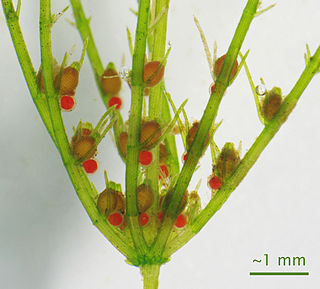A hermaphrodite is an organism that possesses both male and female reproductive organs during its life.
Contents
Hermaphrodite may also refer to:
A hermaphrodite is an organism that possesses both male and female reproductive organs during its life.
Hermaphrodite may also refer to:

Sex is the trait that determines whether a sexually reproducing organism produces male or female gametes. Male organisms produce small mobile gametes, while female organisms produce larger, non-mobile gametes. Organisms that produce both types of gametes are called hermaphrodites. During sexual reproduction, male and female gametes fuse to form zygotes, which develop into offspring that inherit traits from each parent.

A sex organ, also known as a reproductive organ, is a part of an organism that is involved in sexual reproduction. Sex organs constitute the primary sex characteristics of an organism. Sex organs are responsible for producing and transporting gametes, as well as facilitating fertilization and supporting the development and birth of offspring. Sex organs are found in many species of animals and plants, with their features varying depending on the species.

Sexual differentiation is the process of development of the sex differences between males and females from an undifferentiated zygote. Sex determination is often distinct from sex differentiation; sex determination is the designation for the development stage towards either male or female, while sex differentiation is the pathway towards the development of the phenotype.

Sequential hermaphroditism is one of the two types of hermaphroditism, the other type being simultaneous hermaphroditism. It occurs when the organism's sex changes at some point in its life. In particular, a sequential hermaphrodite produces eggs and sperm at different stages in life. Sequential hermaphroditism occurs in many fish, gastropods, and plants. Species that can undergo these changes do so as a normal event within their reproductive cycle, usually cued by either social structure or the achievement of a certain age or size. In some species of fish, sequential hermaphroditism is much more common than simultaneous hermaphroditism.

Male is the sex of an organism that produces the gamete known as sperm, which fuses with the larger female gamete, or ovum, in the process of fertilization. A male organism cannot reproduce sexually without access to at least one ovum from a female, but some organisms can reproduce both sexually and asexually. Most male mammals, including male humans, have a Y chromosome, which codes for the production of larger amounts of testosterone to develop male reproductive organs.
Sexual characteristics are physical traits of an organism which are indicative of or resultant from biological sexual factors. These include both primary sex characteristics, such as gonads, and secondary sex characteristics.

True hermaphroditism, sometimes referred to as ovotesticular syndrome, is an outdated term for an intersex condition in which an individual is born with both ovarian and testicular tissue. Commonly, one or both gonads is an ovotestis containing both types of tissue.

Gonadal dysgenesis is classified as any congenital developmental disorder of the reproductive system in humans. It is atypical development of gonads in an embryo,. One type of gonadal dysgenesis is the development of functionless, fibrous tissue, termed streak gonads, instead of reproductive tissue. Streak gonads are a form of aplasia, resulting in hormonal failure that manifests as sexual infantism and infertility, with no initiation of puberty and secondary sex characteristics.

Sexual differentiation in humans is the process of development of sex differences in humans. It is defined as the development of phenotypic structures consequent to the action of hormones produced following gonadal determination. Sexual differentiation includes development of different genitalia and the internal genital tracts and body hair plays a role in sex identification.
Pseudohermaphroditism is a condition in which an individual has a matching chromosomal and gonadal tissue sex, but mismatching external genitalia.

A hermaphrodite is a sexually reproducing organism that produces both male and female gametes. Animal species in which individuals are of different sexes, either male or female but not both, are gonochoric, which is the opposite of hermaphroditic.
The reproductive system of an organism, also known as the genital system, is the biological system made up of all the anatomical organs involved in sexual reproduction. Many non-living substances such as fluids, hormones, and pheromones are also important accessories to the reproductive system. Unlike most organ systems, the sexes of differentiated species often have significant differences. These differences allow for a combination of genetic material between two individuals, which allows for the possibility of greater genetic fitness of the offspring.

An organism's sex is female if it produces the ovum, the type of gamete that fuses with the male gamete during sexual reproduction.

Intersex people are individuals born with any of several sex characteristics including chromosome patterns, gonads, or genitals that, according to the Office of the United Nations High Commissioner for Human Rights, "do not fit typical binary notions of male or female bodies".
46,XX/46,XY is a chimeric genetic condition characterized by the presence of some cells that express a 46,XX karyotype and some cells that express a 46,XY karyotype in a single human being. The cause of the condition lies in utero with the aggregation of two distinct blastocysts or zygotes into a single embryo, which subsequently leads to the development of a single individual with two distinct cell lines, instead of a pair of fraternal twins. 46,XX/46,XY chimeras are the result of the merging of two non-identical twins. This is not to be confused with mosaicism or hybridism, neither of which are chimeric conditions. Since individuals with the condition have two cell lines of the opposite sex, it can also be considered an intersex condition.
Christiane Völling is the first intersex person known to have successfully sued for damages in a case brought for non-consensual surgical intervention described as a non-consensual sex reassignment. She was awarded €100,000 by the Regional Court of Cologne.

Intersex, in humans and other animals, describes variations in sex characteristics including chromosomes, gonads, sex hormones, or genitals that, according to the UN Office of the High Commissioner for Human Rights, "do not fit typical binary notions of male or female bodies". Intersex people were historically termed hermaphrodites, "congenital eunuchs", or even congenitally "frigid". Such terms have fallen out of favor, now considered to be misleading and stigmatizing.

Intersex people are born with sex characteristics, such as chromosomes, gonads, or genitals that, according to the UN Office of the High Commissioner for Human Rights, "do not fit typical binary notions of male or female bodies".

The (DoDI) 6130.03, 2018, section 5, 13f and 14m is the writing which bars persons with "true hermaphroditism", "pseudohermaphroditism" and "pure gonadal dysgenesis" from serving in the United States Armed Forces. The three are all intersex conditions and are as of now considered to be medically incompatible with military service in the United States. "DoDI" stands for "Department of Defense Instruction," the 6130.03 instruction concerns "Medical Standards for Appointment, Enlistment, or Induction in the Military Services" in the Armed Forces of the United States. Section 5 focuses on disqualifying conditions of the male and female reproductive system, on the female page the subheader 13 and paragraph f name true hermaphroditism, pseudohermaphroditism and pure gonadal dysgenesis specifically, and on the male page the subheader 14 and paragraph m also name exactly true hermaphroditism, pseudohermaphroditism and pure gonadal dysgenesis, respectively. There is no differentiation made between males and females with these conditions. Many doctors, medical professionals and intersex advocates find the terms hermaphroditism to be outdated and stigmatized, therefore it and its derivative words are seldom used in the 2000s, with the word hermaphrodite itself being considered a slur when used against a human.
Intersex is a general term for an organism that has sex characteristics that intermediate between male and female. The term intersex typically applies to members of gonochoric species that are usually sterile. Mammals are solely gonochoric. It is not to be confused with the term hermaphrodite.